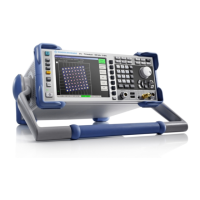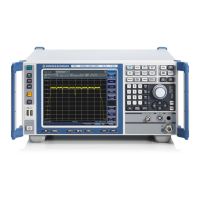Common Analysis and Display Functions
R&S
®
ESW
235User Manual 1177.6298.02 ─ 08
11.4.3.1 Marker Search
Access: "Overview" > "Analysis" > "Marker" > "Search"
Markers are commonly used to determine peak values, i.e. maximum or minimum val-
ues, in the measured signal. Configuration settings allow you to influence the peak
search results.
Search Mode for Next Peak........................................................................................235
Peak Excursion........................................................................................................... 235
Search Limits (Left / Right)..........................................................................................235
Search Threshold........................................................................................................236
Deactivating All Search Limits.....................................................................................236
Search Mode for Next Peak
Selects the search mode for the next peak search.
"Left"
Determines the next maximum/minimum to the left of the current
peak.
"Absolute"
Determines the next maximum/minimum to either side of the current
peak.
"Right"
Determines the next maximum/minimum to the right of the current
peak.
Remote command:
Find a list of remote commands in Chapter 15.7.4.4, "Marker Positioning",
on page 545.
Peak Excursion
Defines the minimum level value by which a signal must rise or fall so that it is identi-
fied as a maximum or a minimum by the search functions.
Entries from 0 dB to 80 dB are allowed; the resolution is 0.1 dB. The default setting for
the peak excursion is 6 dB.
Remote command:
CALCulate<n>:MARKer<m>:PEXCursion on page 463
Search Limits (Left / Right)
If activated, limit lines are defined and displayed for the search. Only results within the
limited search range are considered.
Remote command:
CALCulate<n>:MARKer<m>:X:SLIMits[:STATe] on page 543
CALCulate<n>:MARKer<m>:X:SLIMits:LEFT on page 544
CALCulate<n>:MARKer<m>:X:SLIMits:RIGHt on page 544
Marker Usage

